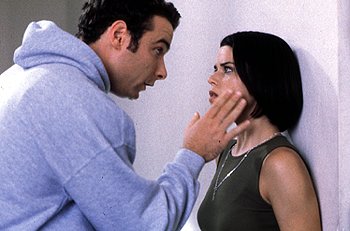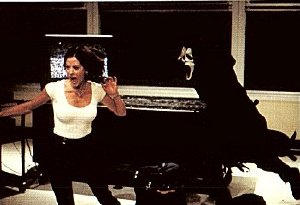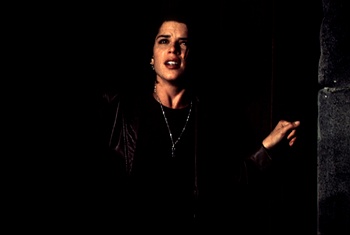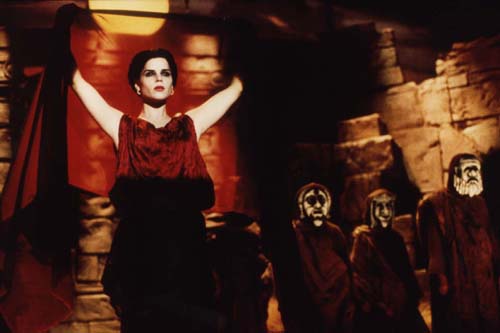








As editor/publisher/Cobra-in-Chief, I feel duty bound to redress certain injustices in society. One such is the under appreciation of Scream 2, which may seem perverse in that it grossed over $100 million in its domestic release. Still, it was ghettoized as a teen slasher sequel thing even by its most sympathetic reviewers, and rarely praised for its nuanced writing, concise plotting, and emotional intensity--qualities lacked by, for instance, every movie nominated for a Best Picture Oscar this year. If you haven't seen it but plan to, I reveal plot points with impunity so stop reading right now. I'm guessing, though, that you either already have seen it or have decided never to see it and have tried to proceed accordingly. --ed.
To begin, Scream 2 is the prettiest slasher flick ever made. Bright and vibrant as an ad for Tide, it was filmed by Peter Deming (whose career has one foot in comedies, like Austin Powers: International Man of Mystery and House Party and the other in spiky horror romps like Lost Highway and zombie jamboree Evil Dead 2) in a high gloss style unusual in sequels to horror films. The result is a look that flatters even the dopey maroon streaks in Courtney Cox's hair while making the numerous murders, while not spectacularly gory, piquantly upsetting in their brightly lit execution.
But the gap between audience expectations of a movie filmed in the manner of My Best Friend's Wedding and the body count of Macbeth is only the beginning of Scream 2's artless sophistication. It takes the most benighted of sub-sub-genres, the slasher movie sequel, and invests it with tidy plotting, emotional resonance, and grounds for playful wit.
Consider the prologue: Maureen, the female half of a black couple attending the premier of Stab (the movie within a movie retelling of the events in Scream) derides the Anglocentric bent of most horror movies and coaches the silly blond screen prey from the audience. Meanwhile, a real killer murders her boyfriend in the bathroom, and sporting his bloody coat and the promotional Stab ghost mask worn by most of the audience, replaces him by her side. When she too is stabbed, she staggers to the front of the theater illuminated by the light of the movie, her face a mask of despair and protest against the unfairness of the attack.
The murders are brutal, but not just brutal. Because they are set up so simply, and because the victims don't behave idiotically, the deaths have a nagging plausibility that killer-chasing-the-bimbo-through-the dark-house scenarios lack. Maureen correctly ridicules inept Girl Number One from Stab. She should have hung up on the threatening caller and dialed 911, or *69'ed him. And what was that shower scene about if not gratuitous nudity? But getting stabbed by the guy sitting next to you in a dark, noisy theater? That's harsh. That could happen, man. And what would you do when you noticed your boyfriend's coat was covered in blood? She screamed, but the whole audience was screaming. She moved away, but not quickly enough. Likewise, there was nothing terribly wrong with her boyfriend Phil putting his ear against the stall wall in the mens' room, aside from it being vaguely icky. He heard a girl on the other side and was curious. Who wouldn't be? It's not like he had a reason to expect a knife in the ear.
The lack of blatantly moronic behavior is refreshing in any movie, and nearly unheard of in horror flicks. Even in the original Scream, where the running joke was that the kids so conversant (boy, were they conversant) in the "rules" of horror movies routinely broke them, the characters were so obnoxious and so stupid that it was hard to take a rooting interest in their fates. On the other hand, when chief target Sydney Prescott busts a crank caller by reading his name off of a caller ID box and quotes the federal law he has just violated, you think she has the makings of a heroine. And though there is too much of the standard "you wait here alone and defenseless while I chase the monster" shtick, the twists of the plot fall within the realm of possibility if not likelihood. You could say the same of most Hitchcock movies, if you dared.
What carries the film over its dubious moments is the compassion written into Kevin Williamson's screenplay. Whereas in the original Scream he replicated the annoyances and contrivances of the slasher movies he meant to ridicule, in Scream 2 he not only avoided the pitfalls of sequels, but retooled their weaknesses into strengths.
For instance, characters are usually developed in the original and the sequel just gives them stuff to do. This isn't a problem in Scream 2 because characters weren't developed in the original. In a formula movie about formula movies, types (girl with troubled past, her boyfriend, shrill blond with big boobs, etc.) sufficed. The types return in Scream 2, but with a shared history and a grace noted script which specifies them. Gale Weathers, for example, is not just a careerist bitch reporter, but a careerist bitch reporter who saved the lives of the returning cast and has subsequently written a book about the experience. So while the other characters still shrink from her exploitative bent, their reaction is complicated by the debt they owe her. When she strikes up a romance with goofy Deputy Dewy, it comes as a beguiling surprise. At the end she escapes becoming a caricature of her own ambition by running away from her cameraman and to Dewy's side, she seems to have been not just spared, but saved.
Even the murders which exist to kill time before the returning characters are directly imperiled are composed with care. In the prologue, the couple squabbles about who will pay for the popcorn and the relative merits of movies in which "some dumb-ass white girls get their ass cut the fuck up" and those which feature that icon of ethnicity Sandra Bullock. Then in showing a willingness to compromise they betray a sweetness in their relationship that makes their ensuing slaughter not just scary, but sad. Similarly, the obligatory screaming blond dead meat sorority house inhabitant is delineated as a good natured, responsible, "sober sister," and Sydney's pledge roommate has touchingly humble aspirations. Williamson’s decision to target sympathetic bit players rather than stuck-up campus queens who say, "Hello--I mean that," is in itself a departure. True to movie-rules spokesperson Randy prediction about sequels, the body count is higher in Scream 2; but unexpectedly, the losses also cut deeper.
Another quality of sequels embraced and enlarged in Scream 2 is their inherent familiarity. Williamson confronts this problem head on. The killers (there are, fittingly, two) target victims with the same names as those in the original. This inspires a sense of dread and deja vu in the survivors, and also a lot of chit chat on the nature and worth of sequels, from the undeniably great The Godfather, Part II to Return of the Jedi ("Ewoks—they blow.")
As a means of psychically managing the emerging threat, Sydney engages in art therapy dramatics as Cassandra, the tragic Greek figure doomed to foresee the future without the power to change it. The connection between the characters could have been a pretentious throwaway, but instead Williamson and director Wes Craven weave elements and concepts from Greek theater throughout the movie to fortify their film.
For instance, in the play as in life, the characters are menaced by actors in masks. The carnival-like abandon the liberally distributed ghost masks inspired in the prologue's movie audience enabled a double murder. Later, Syd glimpsed the mask of the killer who infiltrated her dress rehearsal, and after that, masked and cowled figures snatch her boyfriend. Only when the masks come off are stunned audience members, sympathetic co-stars, vengeful frat brothers(angry that Sydney's boyfriend gave her his Greek letter pin), the killers and their motives revealed. Though the last are most dramatic, all the mask wearers are dehumanized, and to some extent, suspect. The mask is so iconic that when Sydney sees her boyfriend wearing one, her fear that he is one of the murderers is unconsciously confirmed, and she is easily manipulated into believing it is so by the real killer.
As in Greek drama, horror plots are preoccupied with issues of heredity. While the Scream trilogy has a postmodern surface (self-conscious imitation of slasher movies, self-conscious imitation of sequels, and self-conscious assertion of directorial independence, respectively), their underlying structure is traditional (sins of the mother visited upon her children, mother's revenge, sins of the mother visited upon her children again, respectively). In Scream 2, each concept is embodied by a killer and an arena. The prologue is the realm of the young, movie obsessed punk, the finale on the Cassandra set is that of the avenging Mrs. Loomis (the surname borrowed by Halloween from Psycho, then by Scream from Halloween is about as notable a lineage as you will find in horror movies). On the set, Mrs. Loomis shoots her accomplice down--a case of the venerable outgunning the trendy, an emblematic goal for a sequel.
Also appropriate to a sequel, Scream 2 is loaded with doppelgangers. In the context of the story, there are Gale Weathers (pro reporter) and Mrs. Loomis (masquerading as a cub reporter), valiant film geek Randy and evil film geek Mickey, good boyfriend Derek and the palpable memory of really bad boyfriend Billy from Scream. Furthermore, the characters recognize their former selves and friends in the movie within a movie, Stab. The first girl victim in Scream 2 gets killed while watching the first girl victim in Stab get killed.
In the meta-Scream 2 which depends on the audience's outside film knowledge, Gale (Courtney Cox) complains that her face was attached to Cox's Friends co-star Jennifer Aniston's body for internet distribution, Deputy Dewy is played by David Arquette, who appeared on an episode of Friends, and whose father Lewis plays police chief Hartly, Sydney's drama coach is played by David Warner who portrayed Jack the Ripper in Time After Time, and so forth. Real-life Scream fan Paulette Patterson won a MTV sponsored contest and handed Philip and Maureen Stab promotional material at the beginning of the movie. Cinematographer Deming was Popcorn Boy, second assistant DK Arredondo made an amazing Fraternity Brother #2, and director Craven was uncredited as Man at Hospital. These and dozens more touches, which can be found listed on the better Scream dedication pages, indicate the filmmakers knew their audience well enough to plant surprises and reward careful viewing, confident that their viewers would pay attention and be charmed. They were right on both counts.
I haven't written enough in tribute to Wes Craven who so splendidly assembled Scream 2. As one of the horror genre's most notable contributors, he has consistently built his movies around original and compelling insights into the human psyche. That's why his devotees are sorry to lose him to the likes of Music of the Heart. But if Scream won him his first widespread critical acceptance, and Scream 3--with it's packed gallery of indy movie personalities and horror movie director slain for the benefit of mankind (you have seen Scream 3, haven't you?) marked Craven's entree into the mainstream and departure from the genre respectively, Scream 2 shows how very deft he can be.